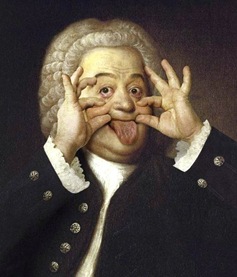WILLIAM BOYCE
Un importante hombre del barroco, postergado pese al valor musical de su obra.
Músico y
compositor inglés del barroco, nacido en Londres (11 septiembre 1711 - 7
febrero 1779).
 Se inició en
las artes musicales como niño cantor de la catedral de San Pablo,
posteriormente estudió órgano con Maurice Greene organista y compositor. Su
primer trabajo profesional como organista de la Oxford Chapel fue en 1732,
ocupando similares puestos antes de ser
nombrado como “Master of the King´s Music” en el año 1755, llegando a ser
organista en la Chapel Royal en el año 1758.
Se inició en
las artes musicales como niño cantor de la catedral de San Pablo,
posteriormente estudió órgano con Maurice Greene organista y compositor. Su
primer trabajo profesional como organista de la Oxford Chapel fue en 1732,
ocupando similares puestos antes de ser
nombrado como “Master of the King´s Music” en el año 1755, llegando a ser
organista en la Chapel Royal en el año 1758.
Un creciente
problema de la audición que le condujo a
una sordera le impidió continuar en su labor
de organista, situación que aprovechó para retirarse para trabajar en la
compilación de la música de la catedral.
Trabajo que le permitió editar trabajos de William Byrd y Henry
Purcell.
Entre sus
obras encontramos un conjunto de ocho antífonas (anthems o himnos) y sus odas.
También escribió La mascarada "Peleus and Thetis" y canciones para "The Secular
Masque" (de John Dryden), música incidental para las obras de William
Shakespeare - "La tempestad" (teatro), "Cymbeline", "Romeo y Julieta" y "The winter’s
tale" - y una gran cantidad de música de cámara incluyendo un lote de doce de
trío sonatas.
Boyce fue
totalmente olvidado después de su muerte y aún hoy en día es un compositor poco
tocado, a pesar de que un gran número de sus obras fueron descubiertas en los
años 1930 y que Constant GJLambert editó y algunas veces interpretó sus obras.
Jorge II le otorga a William Boyce, licencia para publicar su música.
George II grants Boyce a Royal License to publish his
music (10 April 1745).
GEORGE the Second, by the Grace of God, King of Great Britain, France and Ireland, Defender of the Faith &c. To all to whom these Presents shall come, Greeting: Whereas William Boyce, one of the Composers of Our Chapels Royal, hath humbly represented unto Us, that he hath with great Study, Labour and Expence, composed several Works, consisting of Vocal and Instrumental Musick, in order to be printed and published, and hath therefore humbly besought Us, to grant him Our Royal Privilege, and Licence for the sole Printing and Publishing thereof, for the Term of Fourteen Years: We being willing to give all due Encouragement to Works of his Nature, are graciously pleased to condescend to his Request, and We do therefore by these Presents, so far as may be agreeable to the Statute in that Behalf made and provided, grant unto the said William Boyce, his Executors, Administrators and Assigns, Our Licence for the sole Printing and Publishing the said Works, for the Term of Fourteen Years, to be computed from the Date hereof, strictly forbidding all our Subjects, within our Kingdom and Dominions, to reprint or abridge the same, either in the like or any other Volume or Volumes whatsoever, or to import, buy, vend, utter or distribute any Copies there of reprinted beyond the Seas, during the aforesaid Term of Fourteen Years, without the Consent or Approbation of the said William Boyce, his Heirs, Executors and Assings, as they will answer the contrary at their Perils, Whereof the Commissioners and other Officers of our Customs, the Master, Wardens an Company of Stationers, are to take Notice that due Obedience may be rendered to our Pleasure herein declared . Given at Our Court at St. James’s the Tenth Day of April 1745 in the Eighteenth Year of Our Reign.By His Majesty’s CommandHOLLES NEWCASTLE
Fuente:
William Boyce: A Tercentenary Sourcebook and Compendium - Ian Bartlett, Robert J. Bruce - Pág/39 (Google Books)
William Boyce: A Tercentenary Sourcebook and Compendium - Ian Bartlett, Robert J. Bruce - Pág/39 (Google Books)
12 Sonatas
en trío
Set de 12 tríos sonatas, siguiendo una moda que se había iniciado con Corelli en el siglo anterior y que ahora estaba llegando a su fin.12 Oberturas
2 Concerti
Grossi
8 SINFONÍAS: Link
Música instrumental:
La música instrumental de Boyce incluye un set de 8 sinfonías en ocho partes, publicadas en 1760, composiciones que reflejan el cambio de gusto de esa época
- Sinfonía
N° 1 en Si bemol Mayor
- Sinfonía N° 2 en La Mayor
- Sinfonía N° 3 en Do Mayor
- Sinfonía N° 4 en Fa Mayor
- Sinfonía N° 5 en Re Mayor
- Sinfonía N° 6 en Fa Mayor
- Sinfonía N° 7 en Si bemol Mayor
- Sinfonía N° 8 en Re Menor
10
Voluntaries para órgano o clavecín
ODAS:
- Birthday ode for George III
- King’s ode for the New Year
- Ode to St. Cecilia’s Day
- Pindar’s Ode
ANTHEMS:
- By the Waters of Babylon
- I have surely built thee an house
- O be joyful
- O Give Thanks
- O Praise the Lord
- O Where shall Wisdom be found
- The Lord is King
- Turn thee unto me
- Wherewithal shall a young man
ORATORIOS:
- David’s Lamentation over Saul and Jonathan
DRAMAS MUSICALES Y OPERAS:
- The chaplet
- The Shepherd’s Lottery
- Corydon and Miranda
- Peleus and Thetis
MÚSICA CORAL
Y VOCAL
Una de las
canciones más conocidas de Boyce es The patriotic "Heart of Oak" Link. Su música de liturgia religiosa, aún tiene un lugar en el repertorio de la catedral anglicana,
Agradecimientos a canal de: Stefan Swarz - youtube
Páginas de Interés
- Completa biografia de W. Boyce
- William Boyce - The Eight Symphonies (En)
- Eighteenth Century English Music - William Boyce (En)























